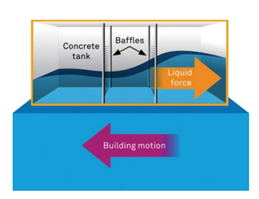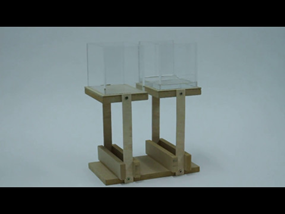Tall Buildings and Sloshing Dampers: How Engineered Water Tanks Are Helping People Live Better
Can tall buildings, made of steel and concrete, really sway in the wind? Yes! The taller and slenderer, the more they are prone to sway. Some buildings may sway nearly 12 inches, and occupants would be none the wiser.
But for other structures, without careful design and planning, sway can have a negative impact on those living and working inside, with symptoms ranging from mild (headaches and dizziness) to severe (balance issues and motion sickness). Excess sway may also lead to increases in maintenance costs due to ‘structural fatigue’ as repeated loading can result in wall cracks or façade damage.
As cities around the world are expanding upwards, it is important that these issues are considered.
How can water tanks help with this, and how can they help occupants live better? Simple: Energy absorption. If a tall building is prone to too much sway, it is outfitted with dampers, devices that are specifically engineered to suppress this motion. More specifically, this article will take a closer look at the Tuned Liquid Sloshing Damper (TLSD), which use water tanks to do just that.
BRIEF HISTORY
Though the concept of motion damping has been known for centuries, dampers for reducing tall building motion were not implemented until 1969, for the World Trade Center in New York, with the first TLSD installation in 1995 for Hong Kong’s Highcliff Apartments. As of 2018, nearly 15% of the world’s top 50 tallest towers employ TLSDs (ref). They are an attractive solution due to their cost effectiveness, low maintenance and relative simplicity.
WHAT IS A SUPPLEMENTAL DAMPING SYSTEM?
Every structure has a level of ‘built-in’ damping, or ability to suppress vibration. In some cases, however, this may be inadequate for reducing high acceleration or sway. As its name suggests, a supplemental damping system, or damper for short, has only one purpose: add more damping to the building.
The construction and principle of the Tuned Liquid Sloshing Damper is quite simple. A TLSD is a rectangular concrete tank which is partially filled with water. Inside, small obstructions (screens, baffles, posts) are placed along the bottom. As the building moves, the water is pushed in the opposite direction through or around the obstructions. By way of drag and inertial forces, the energy of the water (and by extension the building) is dissipated, helping to reduce overall sway and acceleration. The damper can be tuned to a specific building by adjusting the water height and tank dimensions to maximize performance.

Figure 1: Working Principle of a TLSD (ref)
An excellent visual is provided here, showing the basic principle of a TLSD, despite not having screens.

Figure 2: Simple Sloshing Damper Model, https://www.youtube.com/watch?v=DrAMcSf6TH0
WHAT RESEARCH IS SUPPORTING TLSD MODELLING?
Recent research by Gradient Wind’s Principal, Un Yong Jeong (Ph.D., P.Eng.), and Junior Wind Scientist, Stéphanie Hartlin (M.Sc., B.A.Sc.), present a new time domain analysis scheme for the analysis of non-linear multi-mode Tuned Liquid Sloshing Dampers. Their research will be presented at the upcoming 16th International Conference on Wind Engineering, from August 27-31, in Florence, Italy. To find out details on how to register and for more information, click this link.
In TLSDs, drag is one of the main damping forces which acts to suppress excess sway. The analysis is considered ‘non-linear’ since drag is proportional to water velocity squared. The equation is often simplified by linearization of the term. The non-linear form of the analysis, however, requires no such assumption maintaining a high level of accuracy.
The analysis also includes the use of ‘multi-sloshing modes’, which are usually ignored. Only the first mode is typically considered because it governs most of the energy dissipation. However, in cases where we want to consider multiple screens and lower water levels of sloshing, modelling with more sloshing modes can allow for more accurate representation of the flow behavior.
Un Yong and Stephanie explore a modelled tall building-TLSD system under linear and non-linear analysis. Their findings inform us that a linear analysis will overestimate the efficiency of the damper and, in turn, may result in a less conservative damper in the initial design stage. Having a more accurate and conservative estimation of required damping is therefore essential for these challenging projects to ensure proper motion control. Is it in this way that the current approach to TLSD analysis can help to improve the future design and implementation of sloshing dampers for use in tall buildings.
***
At Gradient Wind, we can provide initial consultation for damping options, and when necessary, detailed design of the TLSD using our dynamic test rig. This rig simulates the damping effect that the TLSD would impose upon the full-scale building. If you would like more details about whether a TLSD or other supplemental damping system is needed for your development, contact us at [email protected] for more information.

